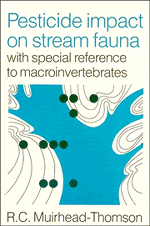Book contents
- Frontmatter
- Contents
- Preface and Acknowledgements
- PART I INTRODUCTION AND ORIGIN OF PESTICIDES IN RUNNING WATERS
- PART II THE ROLE OF LABORATORY AND EXPERIMENTAL METHODS IN EVALUATION
- PART III EVALUATION IN PEST CONTROL PROJECTS
- SIX Introduction to field sampling of aquatic macroinvertebrates in streams and rivers
- SEVEN Impact of insecticides used in control of the spruce budworm
- EIGHT Aquatic environmental effects of insecticides used in tsetse fly control
- NINE Effect on non-targets of larvicides applied to running waters for control of blackfly (Simulium) larvae
- TEN Impact of piscicides (and molluscicides)
- ELEVEN Herbicides and aquatic invertebrates
- Summary and assessment
- References
- Index
ELEVEN - Herbicides and aquatic invertebrates
Published online by Cambridge University Press: 05 November 2011
- Frontmatter
- Contents
- Preface and Acknowledgements
- PART I INTRODUCTION AND ORIGIN OF PESTICIDES IN RUNNING WATERS
- PART II THE ROLE OF LABORATORY AND EXPERIMENTAL METHODS IN EVALUATION
- PART III EVALUATION IN PEST CONTROL PROJECTS
- SIX Introduction to field sampling of aquatic macroinvertebrates in streams and rivers
- SEVEN Impact of insecticides used in control of the spruce budworm
- EIGHT Aquatic environmental effects of insecticides used in tsetse fly control
- NINE Effect on non-targets of larvicides applied to running waters for control of blackfly (Simulium) larvae
- TEN Impact of piscicides (and molluscicides)
- ELEVEN Herbicides and aquatic invertebrates
- Summary and assessment
- References
- Index
Summary
INTRODUCTION
The use of herbicides to control undesirable plant growth first developed on a large scale shortly after World War II and has been extending rapidly ever since that time. With their increasing use in agriculture, forestry and water-way clearance particularly in developing countries these chemicals now rank alongside insecticides as major environmental contaminants (Balk & Koeman, 1984). The continuous monitoring programme of streams flowing into the Great Lakes over the last 10 years for example, has shown that herbicide use in agricultural land has now increased to such an extent that they now constitute more than half the total volume of pesticides used in agriculture (Frank et al., 1982). Even in the UK where there are unusually stringent regulations controlling pesticides in the environment – particularly with regard to natural water bodies – many of the long-established herbicides such as 2, 4-D, dalapon, dichlobenil and diquat have been cleared under the Pesticides Safety Precautions Scheme, 1973, for use as aquatic herbicides for control of submerged and emergent aquatic weeds, and for the control of vegetation along the banks of rivers and drainage channels (Ministry of Agriculture, Fisheries & Food, 1985).
Early recognition of possible effects on fish life of herbicides applied directly to water or contaminating water by run-off from agricultural land, led to very thorough laboratory investigations in the UK on fish toxicity, and established the relative lethal levels of about 20 common herbicides based on 24-h LC50 values (Alabaster, 1969).
- Type
- Chapter
- Information
- Pesticide Impact on Stream FaunaWith Special Reference to Macroinvertebrates, pp. 223 - 229Publisher: Cambridge University PressPrint publication year: 1987

